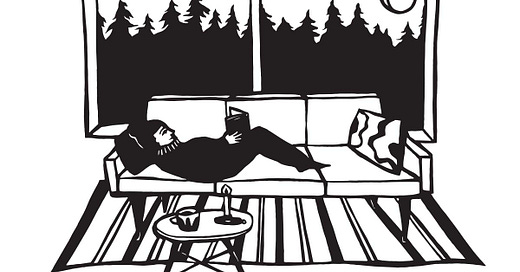24 Days of Making, Doing, and Being: December 10
Jólabókaflóð: a tradition of books and reading.
Welcome to 24 Days of Making, Doing, and Being, a digital Advent calendar for slowing down and making space for presence, creativity, and gratitude. If you missed a day you can catch up here.
This is a seasonal offering for paid subscribers, but since the regular Creative Fuel schedule is a little different this month, I am sending a few previews to all of you throughout these weeks. Today’s is one of my favorite traditions, so I wanted to share with everyone.
We have another calendar tradition today: Jólabókaflóð.
Jólabókaflóð is Iceland’s Christmas “book flood.” Books are often the gift of choice, and given on Christmas Eve, which means you can stay up late into the night reading.
Every year around this time you’ll see this cultural tradition making the rounds on the internet, good evidence that a lot of us are craving rituals that are slower in nature. And as any reader or writer knows: books are magic. I for one welcome a book flood.
This season is an essential period for the Icelandic publishing industry, and many new titles are released. The “book flood” means that Christmas sales account for around 40%1 of total annual book sales.
It makes sense that there would be a holiday book buying frenzy in a country so committed to literature. For a small country, it’s a publishing powerhouse. Around five titles are published per 1,000 residents in Iceland. That makes a print run of 1,000 copies in Iceland the same as one million copies in the United States2. Over a third of Icelanders3 read or listen to a book on a daily basis, and the capital city Reykjavík is designated a UNESCO City of Literature. “We are a culture that’s obsessed with storytelling. It’s a national pastime,” author and researcher Baldur Bjarnason told the Smithsonian.
But back to the book flood. In November, the Icelandic Publishers Association publishes Bókatíðinda. The catalog contains all of the new book titles, and people peruse the pages to figure out what best books to give for the holidays. You don’t want to be the person caught not giving a book now do you?
This “book flood” tradition began during World War II, when paper was one of the few commodities that wasn’t rationed, but the Icelandic literary roots extend much farther back. Emerging in the 12th century, the famed Icelandic Sagas are the backbone of Icelandic literature. These stories from centuries ago still hold power, and the sagas are, “where everything begins for us, our literature, our history and our identity,” says Maríanna Clara Lúthersdóttir.
Winter played its role too in the development of literary culture. Kvöldvaka, evening vigils, were once held to get people through the dark and cold winters of the Middle Ages. As they gathered together in their farmhouses to stay warm and do their “winter work” (like spinning wool, mending clothing, and making tools), someone would read from a book or recite stories. Stories were passed along, and the younger generation learned to read.
A winter tradition of making and storytelling. Even in our modern world where winter doesn’t hold the same threats as it once did, the season still draws us inwards. When the outside world is cold and dark, we retreat to spend our time creating and dreaming.
"A book, too, can be a star, a living fire to lighten the darkness, leading out into the expanding universe."
– Madeleine L'Engle
Jólabókaflóð is an annual feature in this calendar because there’s power in a tradition that revolves around books and reading.
When I originally started writing this calendar, I wanted to come up with ideas that didn’t have anything to do with consumption. Of course, if you are going to consume, your local independent bookstore is pretty much the best place to do it. I personally put books in the “doesn’t count” category of spending. But in the name of something different, I started my own little tradition: gifting library books.
I know, sounds a bit strange, but hear me out.
Every year, on an afternoon at some point in the days leading up to Christmas, I wander into my local library. I walk around the shelves and see what pops out—titles, topic, and maybe even just the cover art. As opposed to keeping an eye on book lists and ordering exactly what I think someone might like, I let serendipity do the work. It’s a small, rural library, and that’s part of the experience: the choices are limited. Which is how you end up with unexpected and delightful things like a small book on philosophy and birds.
If you’re like me, then you probably have countless books that you want to get to, on a seemingly never-ending list. There’s joy in this unexpected, unplanned way of choosing books. It goes against the tracking and the quantifying of our reading habits, where we’ve taken a beloved pastime and turned it into yet another thing to maximize, make more efficient.
I love this little tradition. For one, it turns the “perfect” choice into something more manageable. Obviously you must ensure that the recipient returns the book—it works better as a tradition for people in your household or family as opposed to far-flung friends—but the benefit is that there’s less pressure if they don’t like the book (it can be returned!). You also get some quiet time walking around the library. Some time that isn’t about figuring out what the “must read” book is, but instead the book that speaks to you on someone’s behalf, or even your own.
As a child, I loved going to the library. The options felt endless. Life was abundant. Access to all of this and just with this little plastic card??? This tradition brings back a little of that magic.
Support your local library. Support your local bookshop. Support your local writer.
Make books a tradition.
-Anna





